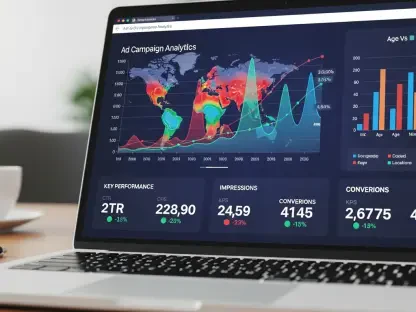The insurance industry, traditionally reliant on face-to-face interactions and paper-based processes, is undergoing a significant transformation. Digital technology is reshaping how insurance companies market their products, engage with customers, and streamline operations. This shift is not just a trend but a necessary evolution to meet the demands of a competitive marketplace and increasingly tech-savvy consumers.
Embracing Digital Marketing Strategies
The Shift from Traditional to Digital
Insurance companies have historically depended on direct mail, print ads, and in-person meetings to reach potential clients. However, the rise of digital marketing has introduced more efficient and effective ways to connect with audiences. Digital campaigns allow for precise targeting, real-time tracking, and optimization, making them indispensable in the modern marketing toolkit. This evolution is particularly essential as consumer behavior continues to migrate towards digital interactions, largely driven by the ubiquity of smartphones and internet accessibility, resulting in a more engaged and interconnected customer base.
The move to digital platforms allows insurance companies to utilize sophisticated marketing tools such as pay-per-click advertising and social media campaigns. Unlike traditional marketing techniques, these methods can be meticulously tracked and adjusted on the fly to improve effectiveness. This level of flexibility is crucial for insurance companies looking to stay competitive in a fast-paced market. Moreover, digital marketing offers the advantage of measurable success, allowing companies to analyze metrics such as customer engagement and conversion rates to continuously refine their strategies.
Content Marketing and SEO
Creating valuable content that educates and engages potential customers is a cornerstone of digital marketing. Blogs, webinars, and podcasts not only establish thought leadership but also improve search engine rankings. By optimizing content for SEO, insurance companies can increase their online visibility and attract more qualified leads. In an age where information is readily accessible, providing insightful and authoritative content helps build trust and brand loyalty among potential clients.
Furthermore, SEO is not just about incorporating relevant keywords; it involves understanding the search intent of potential customers and addressing their needs in a meaningful way. High-quality content crafted with SEO best practices in mind ensures that potential clients find the information they need when searching for insurance solutions online. This strategic approach not only drives organic traffic to an insurance company’s website but also positions the company as an industry leader, making it more likely for visitors to convert into customers.
Social Media Engagement
Social media platforms offer a unique opportunity for insurance companies to interact directly with their audience. Beyond building brand awareness, social media enables personalized targeting and real-time engagement. This direct line of communication helps build trust and fosters stronger customer relationships. Platforms like Facebook, LinkedIn, Twitter, and Instagram have become vital channels for not only promoting insurance products but also for receiving feedback and addressing customer inquiries promptly.
Additionally, social media allows insurance companies to humanize their brand and engage with customers on a more personal level. Sharing success stories, client testimonials, and behind-the-scenes content can make an insurance company more relatable and approachable. The two-way nature of social media interactions also provides valuable insights into customer preferences and pain points, allowing companies to tailor their services accordingly. By leveraging the targeting capabilities inherent in social media platforms, insurance companies can deliver personalized messages that resonate with specific segments of their audience, thereby increasing the overall efficacy of their marketing efforts.
Leveraging Automation for Efficiency
Marketing and Sales Automation
Automation tools have revolutionized marketing and sales processes in the insurance industry. By automating repetitive tasks such as email campaigns, lead scoring, and follow-ups, companies can save time and resources. This efficiency allows marketing teams to focus on more strategic initiatives and improve overall productivity. Marketing automation platforms enable the creation of personalized customer journeys, ensuring each client receives tailored communication suited to their stage in the sales funnel.
Moreover, automation helps in maintaining consistency in customer interactions, ensuring no potential lead falls through the cracks due to manual oversight. These tools provide comprehensive analytics and reporting functionalities, enabling marketing teams to monitor campaign performance, identify trends, and make data-driven decisions swiftly. The integration of AI and machine learning within these platforms further enhances their capabilities, predicting customer behavior and suggesting optimal times for engagement, thus increasing the chances of successful conversions.
CRM Systems Integration
Integrating Customer Relationship Management (CRM) systems with marketing automation tools enhances lead nurturing and communication management. CRM systems store valuable customer data, which can be used to personalize marketing efforts and improve customer interactions. This integration is particularly beneficial for wholesalers, carriers, and brokers who manage large volumes of client information. It allows for a seamless flow of information across different departments, ensuring that every team member has access to up-to-date client data.
Additionally, CRM systems enhance the efficiency of sales teams by providing a centralized repository of all client interactions, making it easier to track the customer journey from initial contact to policy renewal. This holistic view of customer data supports more informed decision-making and more personalized client engagement strategies. By using CRM systems to segment their audience, insurance companies can craft targeted marketing campaigns that address the specific needs and preferences of different client groups, ultimately enhancing customer satisfaction and loyalty.
Harnessing the Power of Data Analytics
Data-Driven Decision Making
The vast amount of data generated by digital interactions provides insurance companies with valuable insights into customer behavior and preferences. By analyzing this data, companies can make informed decisions about their marketing strategies and tailor their offerings to meet customer needs. Data analytics also enables real-time adjustments to campaigns, ensuring they remain effective and relevant. This dynamic approach to decision-making is crucial in a rapidly changing market where customer preferences can shift quickly.
Data analytics tools allow insurance companies to track various performance metrics, such as click-through rates, conversion rates, and customer acquisition costs. By closely monitoring these metrics, companies can identify which aspects of their marketing strategies are working and which need improvement. This iterative approach to marketing ensures resources are allocated efficiently, maximizing the return on investment. Furthermore, advanced analytics techniques, such as predictive modeling, can help insurers anticipate future trends and customer behaviors, allowing them to stay ahead of the competition.
Enhancing Customer Understanding
Understanding customer needs and preferences is crucial for developing effective marketing strategies. Data analytics allows insurance companies to segment their audience and create personalized marketing messages. This targeted approach not only improves customer engagement but also increases the likelihood of conversion. By leveraging customer data, insurers can identify key demographics, behavioral patterns, and preferences, enabling them to tailor their marketing efforts to specific audience segments.
Moreover, data analytics provides insights into the effectiveness of different marketing channels, helping companies understand where to focus their efforts. For example, analyzing social media engagement data can reveal which platforms are most effective in reaching their target audience. Similarly, website analytics can provide insights into user behavior, helping to optimize the customer experience. By continually refining their strategies based on data-driven insights, insurance companies can achieve better outcomes and build stronger relationships with their customers.
The Role of Insurtechs in Digital Transformation
Innovative Tools and Solutions
Insurtech companies are at the forefront of driving digital transformation in the insurance industry. These innovators provide advanced tools and solutions that integrate seamlessly with existing systems. From AI-powered chatbots to blockchain-based platforms, insurtechs offer a range of technologies that enhance efficiency and improve customer experiences. By adopting these cutting-edge solutions, insurance companies can modernize their operations and stay competitive in a rapidly evolving market.
AI-powered chatbots, for example, can provide instant customer service, answering queries and resolving issues around the clock. This not only enhances customer satisfaction but also frees up human resources for more complex tasks. Blockchain technology, on the other hand, offers solutions for secure and transparent data management, reducing the risk of fraud and streamlining administrative processes. Insurtech innovations are continually pushing the boundaries of what is possible in the insurance industry, driving efficiency and delivering superior service to customers.
Collaboration and Integration
Collaboration between traditional insurance companies and insurtechs is essential for successful digital transformation. By integrating modern tools with legacy systems, insurance companies can modernize their operations without the need for complete system overhauls. This collaborative approach ensures a smoother transition and maximizes the benefits of digital technology. Insurtechs bring agility and innovation, while traditional insurance companies offer deep industry knowledge and established customer bases, creating a synergy that drives growth and innovation.
Moreover, partnerships with insurtechs enable traditional insurers to quickly adopt and implement new technologies, staying ahead of competitors who might be slower to innovate. This integration fosters a culture of continuous improvement, where both parties learn from each other and collaboratively develop solutions that address emerging market challenges. By embracing insurtech solutions, traditional insurance companies can enhance their service offerings, improve operational efficiency, and ultimately deliver more value to their customers.
Meeting Customer Expectations
Personalization and Engagement
Today’s consumers expect personalized experiences and instant responses. Digital technology enables insurance companies to meet these expectations by providing tailored content and real-time interactions. Personalization not only enhances customer satisfaction but also builds loyalty and trust. By leveraging customer data, insurance companies can deliver more relevant and timely communications, addressing individual needs and preferences.
Real-time engagement tools, such as live chat and AI-driven customer service platforms, allow insurers to provide immediate assistance, improving the overall customer experience. Personalized marketing messages, tailored product recommendations, and customized policy offerings demonstrate an insurer’s commitment to understanding and meeting the unique needs of their clients. This level of personalization fosters a deeper connection between the insurer and the customer, increasing the likelihood of long-term loyalty and retention.
Agile Responses to Market Dynamics
The insurance industry is constantly evolving, with new regulations, market trends, and customer demands. Digital technology allows companies to respond quickly to these changes, ensuring they remain competitive. Agile marketing strategies and real-time data analysis enable insurance companies to adapt their approaches and stay ahead of the curve. By closely monitoring market dynamics and customer feedback, insurers can identify emerging trends and adjust their strategies accordingly.
Agility in marketing also involves experimenting with new channels and optimizing existing ones through data-driven insights. For instance, if a particular social media campaign is not performing as expected, companies can quickly pivot and allocate resources to more effective strategies. This iterative approach not only maximizes the impact of marketing efforts but also ensures that companies remain responsive to changing customer needs and market conditions. In a fast-paced industry, the ability to adapt and innovate is crucial for maintaining a competitive edge.
Future Prospects of Digital Transformation
Continuous Innovation
The digital transformation journey is ongoing, with continuous advancements in technology shaping the future of insurance marketing. Companies must stay abreast of emerging trends and invest in innovative solutions to maintain their competitive edge. Embracing a culture of continuous improvement will be key to sustaining growth and success in the digital age. This means fostering an environment that encourages experimentation, learning, and the adoption of new technologies.
Staying current with technological trends involves not only adopting new tools but also revisiting and refining existing processes. Companies that are agile and willing to experiment with emerging technologies, such as predictive analytics, artificial intelligence, and machine learning, will be better positioned to anticipate market demands and capitalize on new opportunities. Continuously seeking out and integrating innovative solutions ensures that insurance companies remain at the forefront of the industry, delivering superior value to their customers and driving long-term growth.
Sustainable Growth
The insurance industry, which traditionally relied on face-to-face interactions and paper-based processes, is experiencing a significant transformation through digital technology. This evolution is reshaping the way insurance companies market their products, engage with customers, and manage their operations. Moving away from the old methods, digital technology is enabling real-time interactions and more personalized customer experiences. The change is essential, not just a trend, driven by the demands of a competitive marketplace and the expectations of increasingly tech-savvy consumers.
Today, customers prefer online platforms for purchasing and managing policies, necessitating insurers to adopt advanced digital tools. These tools include artificial intelligence for customer service, big data analytics for risk assessment, and mobile apps for policy management. This digital shift allows for faster processing times, more accurate data analysis, and improved customer satisfaction. Insurers that embrace this transformation can better meet consumer needs and stay competitive in a rapidly evolving market.









